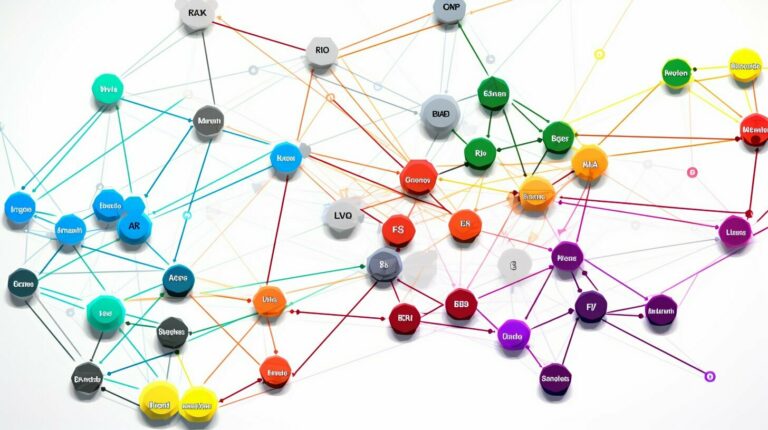Microservices have gained immense popularity due to their ability to increase agility, scalability, and resilience in modern application development. However, with the rise of complex and distributed microservices architecture, efficient communication between services has become a critical challenge. In this article, we will explore the various communication patterns and technologies that enable seamless inter-service communication in microservices.
Microservices communication involves a range of patterns such as synchronous and asynchronous communication, event-driven communication, message-oriented communication, RESTful communication, and gRPC communication. Choosing the right communication pattern and technology is crucial for developing a scalable and efficient microservices architecture.
Key Takeaways:
- Microservices communication is essential for seamless inter-service connectivity in modern applications.
- Various communication patterns, such as synchronous and asynchronous communication, can be used in microservices architecture.
- The right communication pattern and technology must be chosen for developing a scalable and efficient microservices architecture.
Understanding Microservices Communication Patterns
Microservices communication is essential to ensuring that your application’s services work together seamlessly. There are various communication patterns that you can use in microservices architecture, each with its own strengths and weaknesses. Understanding these patterns can help you to choose the right communication strategy for your application.
Here are some of the communication patterns you can use in microservices:
- Synchronous communication: This pattern involves services sending requests and waiting for responses in real-time. This can be useful for services that need to exchange data quickly, but it can also result in slow performance and increased coupling between services. Common examples of synchronous communication protocols include HTTP and RPC.
- Asynchronous communication: This pattern involves services sending messages to each other without waiting for a response. This can be useful for services that don’t need an immediate response and for reducing coupling between services. Common examples of asynchronous communication protocols include message queues and publish/subscribe systems.
- Event-driven communication: This pattern involves services communicating with each other through the publication and consumption of events. This can be useful for services that need to react to changes in the system and for decoupling services. Common examples of event-driven communication systems include Apache Kafka and RabbitMQ.
Each of these communication patterns has its own advantages and use cases. By understanding these patterns, you can choose the right communication strategy for your application’s needs.
Scalable Communication in Microservices Architecture
One of the main challenges in a microservices architecture is achieving efficient and scalable communication between services. As the number of services grows, so does the complexity of managing the interactions and dependencies between them. In this section, we will explore some strategies for achieving efficient and scalable communication in microservices architecture.
Service Discovery
Service discovery is the process by which services can locate and communicate with each other. In a microservices architecture, service discovery is critical for enabling efficient inter-service communication. Rather than hard-coding IP addresses and ports for each service, services can be registered with a service registry and their locations can be dynamically obtained at runtime.
By using a load balancer in conjunction with service discovery, traffic can be routed to available instances of a service. This ensures that the load is balanced across multiple instances of a service, and new instances can be added or removed as needed for scalability.
Asynchronous Communication
Asynchronous communication is an effective way of achieving scalability in microservices architecture. By using asynchronous messaging systems such as message queues, services can communicate in a decoupled and resilient manner. This improves system reliability and makes it easier to scale individual services independently of each other.
Message queues such as RabbitMQ or Apache Kafka allow messages to be sent and received asynchronously, which means that the sender does not have to wait for a response. This makes communication much faster and more efficient, especially when dealing with large volumes of messages or complex processing.
Caching
Caching is another strategy for achieving scalability in microservices architecture. By caching the responses from frequently accessed services, the workload on these services can be reduced, and response times can be improved. Caching can be implemented at various levels of the architecture, including the client-side, server-side, and distributed caching systems.
However, caching also has its drawbacks. The cached data may become stale over time, which can affect the reliability and consistency of the system. To mitigate this risk, various caching strategies can be employed, such as time-based or event-based cache invalidation.
In conclusion, achieving efficient and scalable communication in microservices architecture requires careful planning and consideration of various factors. By using service discovery, asynchronous communication, and caching, developers can build systems that are reliable, flexible, and scalable.
Synchronous Communication in Microservices
Synchronous communication involves a request-response mechanism in which a service sends a request and waits for a response from the receiving service before continuing to execute its code. This pattern is commonly used for short-lived transactions, such as retrieving data from a database or invoking a business rule in another service.
While synchronous communication simplifies the programming model and makes it easier to reason about the flow of data in the system, it introduces dependencies and coupling between services, as the caller must wait for the response from the called service, increasing the risk of bottlenecks and cascading failures.
To mitigate these risks, it is essential to design the API contracts carefully, considering the response time, the payload size, and the error handling strategies, as well as implementing appropriate timeout and retry policies to prevent long waiting times and ensure fault tolerance.
Synchronous Communication in Microservices
Synchronous communication is a commonly used communication pattern in microservices architecture. In synchronous communication, a service waits for a response from another service before completing its request. This pattern is best suited for situations where the requesting service needs immediate feedback and cannot proceed without the response from the called service.
However, synchronous communication can have its limitations, especially when it comes to scalability. As services grow in number and complexity, the synchronous communication pattern can cause bottlenecks and slow down the overall system.
One way to address this challenge is to implement load balancing techniques such as round-robin or least connection routing. Load balancing distributes the requests across multiple instances of a service, ensuring that no single instance is overloaded with requests.
Implementing Synchronous Communication in Microservices
When implementing synchronous communication, it is essential to consider the message size and the latency of the communication. Each service call should be designed to transmit as little data as possible and provide meaningful responses, reducing latency and improving performance.
Moreover, implementing caching mechanisms to store frequently accessed data can help minimize the number of service requests, resulting in faster response times.
Synchronous communication can be implemented using RESTful web services or gRPC. RESTful web services use HTTP for communication, making them widely adopted and easy to develop. However, they can be less efficient than alternative protocols such as gRPC, which uses a binary request and response format, making it faster and more bandwidth-efficient.
Conclusion
Synchronous communication is an essential communication pattern in microservices architecture, especially for applications that require immediate feedback from services. Implementing load balancing techniques, caching, and optimizing message size and latency can help overcome the limitations of synchronous communication and improve overall system performance.
Event-Driven Communication in Microservices
Event-driven communication is a popular and effective communication pattern in microservices architecture. It is a natural fit for loosely coupled services that need to communicate in an asynchronous and decoupled manner. Event-driven communication is based on the Publisher-Subscriber pattern, where a service (publisher) publishes events to a message broker, and other services (subscribers) consume these events.
Event sourcing is a key principle that underlies event-driven communication. It involves persisting all changes to an application’s state as a sequence of events. This approach has several benefits, including better scalability, fault tolerance, and auditability.
Implementing event-driven communication requires the use of a message broker, which acts as an intermediary between publishers and subscribers. Commonly used message brokers include Apache Kafka, RabbitMQ, and Amazon Simple Queue Service (SQS). A message broker can handle large volumes of messages and route them to the appropriate subscribers, ensuring reliable delivery and fault tolerance.
Implementing Event-Driven Communication
When implementing event-driven communication in microservices, it is important to follow some best practices:
- Choose an appropriate message broker that fits your application’s needs.
- Define a clear schema for the events to be published and consumed.
- Ensure that events are idempotent, meaning that they can be safely processed multiple times without causing unintended side effects.
- Use a distributed tracing tool to monitor and diagnose the flow of events between services.
By following these best practices, you can ensure that your event-driven communication architecture is robust, efficient, and reliable.
“Event-driven communication is a powerful pattern for microservices architecture. By using a message broker and following best practices, you can achieve scalable and decoupled communication between services.”
Message-Oriented Communication in Microservices
Message-oriented communication is a popular approach to inter-service communication in microservices. It involves using message queues, message brokers, and event-driven architectures to pass messages between services asynchronously. This method offers several advantages over other communication patterns in terms of reliability, scalability, and decoupling.
Message-oriented communication enables services to communicate without being dependent on each other’s availability or performance. This means that services can operate independently and handle requests at their own pace, without affecting the performance of other services in the system. Additionally, message queues provide a scalable mechanism for handling high volumes of requests, ensuring that no messages are lost or processed twice.
Message brokers act as intermediaries between services, ensuring that messages are delivered reliably and efficiently. They also provide a way to monitor and manage the flow of messages between services. Event-driven architectures enable services to react to events that occur in the system, such as the creation of a new user account or the completion of an order. This enables services to perform specific tasks or workflows in response to events, without needing to actively communicate with other services.
Implementing Message-Oriented Communication
Implementing message-oriented communication requires the use of message queues, message brokers, and event-driven architectures. There are several tools and technologies available for this purpose, including Apache Kafka, RabbitMQ, and AWS Kinesis.
When implementing message-oriented communication, it is important to consider the following best practices:
- Keep messages small and concise to reduce overhead and improve performance.
- Use a durable message queue to ensure that messages are not lost in the event of a failure.
- Implement retries and acknowledgments to ensure reliable message delivery.
- Decouple services by using a shared schema or contract that defines the message formats.
By following these best practices, you can ensure that your message-oriented communication implementation is reliable, scalable, and efficient.
“Message-oriented communication enables services to communicate without being dependent on each other’s availability or performance.”
Overall, message-oriented communication is a powerful tool for enabling seamless and efficient inter-service communication in microservices architecture. By leveraging message queues, brokers, and event-driven architectures, you can achieve a high level of reliability, scalability, and decoupling in your microservices system.
RESTful and gRPC Communication in Microservices
When it comes to inter-service communication in microservices, two popular protocols are RESTful and gRPC. Both have their own strengths and limitations and choosing the right protocol depends on the project’s specific requirements.
RESTful Communication
RESTful communication is based on the HTTP protocol and is widely used for inter-service communication in web applications. It has a simple and familiar interface, making it easy to understand and use. RESTful communication is ideal for stateless services, where each request/response is independent and self-contained.
One of the main benefits of RESTful communication is its compatibility with various programming languages and platforms. RESTful APIs can be easily consumed by different clients, including web browsers, mobile applications, and other services, as long as they can make HTTP requests.
However, RESTful communication is not well-suited for highly complex and data-intensive applications. It relies on a request/response model, which can result in high latency and network overhead, especially when dealing with large payloads. Additionally, RESTful communication does not support bidirectional streaming, which is important for some use cases, such as real-time data processing and chat applications.
gRPC Communication
gRPC is a high-performance, open-source, and cloud-native communication protocol developed by Google. It uses the Protocol Buffers data format for serialization, which is faster and more compact than JSON and XML. gRPC supports both synchronous and asynchronous communication, making it scalable and efficient for microservices architecture.
One of the main benefits of gRPC communication is its speed and efficiency. It can handle high volumes of traffic with low latency and overhead, making it ideal for real-time applications. gRPC also supports bidirectional streaming, allowing services to send and receive data simultaneously.
However, gRPC communication requires more setup and configuration than RESTful communication. It also has fewer client libraries and requires more knowledge of the Protocol Buffers data format. Additionally, gRPC is not compatible with all programming languages and platforms, although support is growing.
Choosing the Right Protocol
Choosing the right communication protocol depends on the project’s specific requirements and constraints. For simple web applications with low inter-service communication needs, RESTful communication may be a good choice. For complex and data-intensive applications with real-time requirements, gRPC communication may be a better fit.
It’s also important to consider other factors, such as team experience, available resources, and existing infrastructure. RESTful communication may be more familiar and easier to implement for some teams, while gRPC may require more expertise and investment in infrastructure.
Ultimately, the choice between RESTful and gRPC communication in microservices depends on the trade-offs between simplicity, speed, scalability, and compatibility.
Conclusion
In this article, we have explored the various communication patterns and technologies used in microservices architecture to achieve efficient inter-service communication. We have discussed the importance of choosing the right communication patterns and technologies to ensure seamless communication between services, which is crucial for modern applications.
By understanding the different communication patterns, such as synchronous, asynchronous, event-driven, and message-oriented communication, we can implement effective communication mechanisms between services. It is also essential to adopt scalable communication strategies to meet the demands of high-volume applications.
RESTful and gRPC communication protocols have their strengths and limitations, and choosing the appropriate protocol depends on the application requirements and architecture.
Choose Communication Strategies Wisely
Effective communication between services is critical for the performance and reliability of microservices architecture. By choosing appropriate communication technologies and patterns, we can avoid communication failures and reduce latency, resulting in a better user experience.
As applications continue to grow and evolve, it is crucial to adopt scalable and efficient communication strategies to meet the demands of high-volume applications.
By following the best practices discussed in this article, developers can design and implement communication mechanisms that ensure efficient inter-service communication in microservices architecture.







